Ralph E. Vaughan's Blog, page 2
March 9, 2022
When Magic is not Enough
I have not written many fantasy stories over the years. Most of my stories fall into the mystery/crime and science fiction genres. The few stories I've written that might be considered Fantasy tend to be plotted more like historicals, such as the Kira stories, which are set in the Bronze Age and follow a female warrior (pre Xena), or the Tawa stories, which feature an indigenous North American girl transported to a prehistoric Europe. They feature ancient tribes and fabulous creatures, sometimes edging into science fantasy, as in the case of "Twilight Journey," but rarely involve traditional magic, which is at the heart of classic high fantasy.
But not all my fantasy stories are bereft of magic. A few feature traditional magic prominently or have plots in which magic is central to the story. In "The Demon of Don't Ask," which appeared in Marion Zimmer Bradley's Fantasy Magazine, the magical system was provided to me because it was set in a shared universe. In other stories, I have been on my own and I did what I always do -- research research research. Yes, I do love to research.
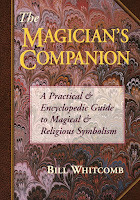 The book I most often turned to for magical verisimilitude was The Magician's Companion by Bill Whitcomb. It contains all that's needed for myriad magical systems, plus provides the tools to customize one's own system. Even in those stories where spells and incantations were not used, it helped in setting up a mindset for those characters to whom dwelling in a magical world was as natural as breathing.
The book I most often turned to for magical verisimilitude was The Magician's Companion by Bill Whitcomb. It contains all that's needed for myriad magical systems, plus provides the tools to customize one's own system. Even in those stories where spells and incantations were not used, it helped in setting up a mindset for those characters to whom dwelling in a magical world was as natural as breathing.
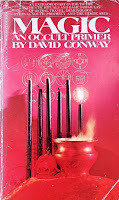 Another book that has proved very helpful over the years is Magic: An Occult Primer by David Conway. This book I have had a very long time. I purchased it from a bookstore in Fitchburg, Massachusetts in the mid 70s. At the time, I was stationed at Ft Devens. On the weekends, when were given time off, we spent our time in various little towns. Littleton was the nicest town we visited, but it was out of the way, and Fitchburg was more convenient. One of the attractions was that there was a bookstore within walking distance of the motel. This was the main book I used as source material when writing Murderer in Shadow, fourth book in the DCI Arthur Ravyn series. Though it is a cozy police procedural novel and not fantasy, the setting is an English village where magic (or the belief in it) is part of everyday life.
Another book that has proved very helpful over the years is Magic: An Occult Primer by David Conway. This book I have had a very long time. I purchased it from a bookstore in Fitchburg, Massachusetts in the mid 70s. At the time, I was stationed at Ft Devens. On the weekends, when were given time off, we spent our time in various little towns. Littleton was the nicest town we visited, but it was out of the way, and Fitchburg was more convenient. One of the attractions was that there was a bookstore within walking distance of the motel. This was the main book I used as source material when writing Murderer in Shadow, fourth book in the DCI Arthur Ravyn series. Though it is a cozy police procedural novel and not fantasy, the setting is an English village where magic (or the belief in it) is part of everyday life.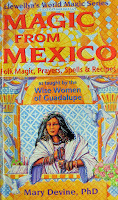 Magic is not always confined to books. Some people believe in magic just as others hold to Christianity, Islam or Science. I don't believe in magic myself, but as the protagonist of Fritz Leiber's Conjure Wife (filmed as Burn Witch Burn-US and Night of the Eagle-UK) discovered, reality is not as important as belief. And I have known a few people personally who followed Wicca and Paganism. And, once, I met a young man who had been cursed by a bruja, a Mexican witch.
Magic is not always confined to books. Some people believe in magic just as others hold to Christianity, Islam or Science. I don't believe in magic myself, but as the protagonist of Fritz Leiber's Conjure Wife (filmed as Burn Witch Burn-US and Night of the Eagle-UK) discovered, reality is not as important as belief. And I have known a few people personally who followed Wicca and Paganism. And, once, I met a young man who had been cursed by a bruja, a Mexican witch.At the time, I handled payroll for about 500 people, and the young man was one of our laborers. One day, his supervisor came to me and told me Juan was having some performance and behavioral issues. That was too bad, I said, because he seemed like a nice young man and had always been a model employee, but what did that have to do with me? Certainly, they were not thinking of terminating him without giving him a chance to redeem himself? After all, we had a lot of long-time employees that were professional goldbricks and ne'er-do-wells, and they were still on the job, at least when they deigned to put in a workday. No, you don't understand, I was told, Juan has been cursed by a witch, and I need you to lift the curse.
I don't often tell people I'm a writer, but word gets around. Mostly, it's because I don't want to read their manuscripts and screenplays. But, as I found out, there are other reasons. I said I did not want to get involved, that I did not believe in curses, and that, even if I did believe in curses, there was nothing I could do about lifting one. But, in the end, I was drafted into the scheme to free Juan from the power of the witch, who, as it turned out, was his girlfriend's grandmother, a bruja of great power from the interior of Mexico and who disliked him intensely.
The supervisor had no idea what we going to to do, but I did. I arranged for the supervisor to bring him to my office that Friday. That gave me a little time to research Mexican magic. Not surprisingly, I had just the book I needed in my library. Friday rolled around, and Juan appeared in my office on time, and, much to Juan's surprise and consternation, I dismissed the supervisor.
For someone as young and impressionable as Juan, a supervisor was almost a demigod. For me to dismiss him, and him obey as quickly as he did, elevated me in the young man's eyes. Most employees never darkened headquarters' door, so it was almost as if Juan had been transported to some supernal realm. And to Juan I was...well, I was odd. I wore a glittering blue coat, a silk cravat with an Eye of Horus pin and a fez with a mystical symbol on it. For the past few days, the supervisor had played me up as a master of the occult. From the look in Juan's eyes, I judged he had reached the proper mindset.
Belief is everything, and when it came to magic and the occult Juan had belief in spades. During my talk with him, I learned that his girlfriend's grandmother did not approve him as a suitor. He had been a bit doubtful about her at first but understood her terrible powers when he saw a goat floating upside-down with candles on its hooves. And that was not all the wonders she showed him...yes, she was very good at manipulation. Then she cursed him and he knew he was doomed. All the bad luck and misfortune was all the proof he needed, but he still loved the girl.
It never does any good to talk True Believers out of anything, so I did not even try. Instead, I gave him the magical parchment I had prepared, had him read it seven times while facing each of the four cardinal points, then told him to burn it in a copper vessel I'd brought to work. We took the ashes outside, buried them in the shade of a cactus, and repeated the Lord's Prayer to the four cardinal points. Afterwards, I gave him several small white stones and had him arrange them in a cross over the ashes.
After that, I heard nothing but good reports about Juan. He was back to being the good employee he had been before being cursed. He also got back together with his girlfriend. The grandmother still thought him an idiot and did not approve, but she had no hold over Juan. He believed his magic was greater than hers, and that was all there was to it.
I really wish I could say that Juan got promoted, that he and the girl got married and that they went on to a long and happy life. Yeah, I wish. We don't need witches or curses to bring tragedy into our lives. Juan had never been part of a gang, though gangs were a part of his culture. Often, avoiding a gang is as dangerous as joining a gang. In July of that year, shortly after the holiday, Juan did not show up for work. A few days later, his body was found in the trunk of a stolen car abandoned out on Otay Lakes Road. The murder remains unsolved.
February 25, 2022
Belloq was Right
Different people recall different portions of favorite films. I tend to remember snippets of dialogue. This actually evolved into something of a game with the Kidette, then a shorthand way of speaking, relating films to daily life. So, if someone tries to do the same old thing, but differently: "He's just changing the dog's name." Or if someone claims to be a good guy: "There are no good guys, there are no bad guys; there's just a bunch of guys." So, while some might take away from Raiders of the Lost Ark the image of the adroit swordsman being shot or an inattentive Nazi being sliced and diced by a flying wing's propeller, I tend to remember what Belloq, the evil French archaeologist, said about his pocket watch:
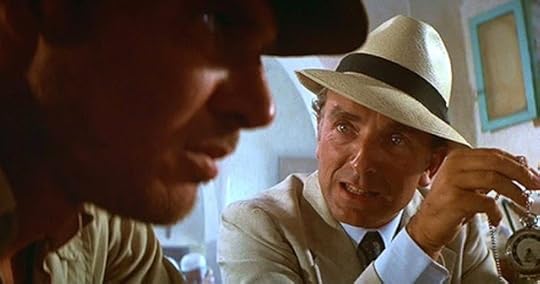 "You know it's worthless. Ten dollars from a vendor in the street. But I take it, I bury it in the sand for a thousand years, it becomes priceless... like the Ark. Men will kill for it. Men like you and me."
"You know it's worthless. Ten dollars from a vendor in the street. But I take it, I bury it in the sand for a thousand years, it becomes priceless... like the Ark. Men will kill for it. Men like you and me."Belloq was right, you know. Let anything acquire a patina of age and it becomes valuable. I often wonder what future archaeologists, whether evolved Cockroaches or visiting scientists from Altair IV, will make of the room where I do all my writing. A book shrine? An ancient library? A temple dedicated to the triune god Asimov-Bradbury-Clarke? And what if my remains are there, my skeleton sitting at a typewriter or laptop? The last Archivist? The Priest of Philip K. Dick and Raymond Chandler? Divine Being? Maybe I'll end up in an alien museum. I do like museums.
However, we need not wait so long to see our things become valuable. Recently, I was book-searching on the internet, curious about some of the Lovecraftian publications from Necronomicon Press. The results were quite startling.
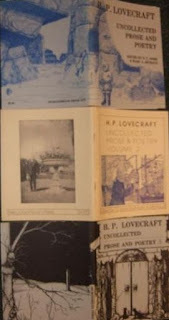 The three booklets pictured contain prose and poetry written by HP Lovecraft that had not been previously collected for publication. Mostly, they consist of amateur writings from HPL's Amateur Press Association days; poetry and essays from what we would now call "fanzines;" poems, essays and vignettes culled from his corpus of letters; and discarded drafts of later stories. When published, they each cost $4.95 in the late 70s, early 80s, so I spent about $15 for all three, plus a modicum of postage. I figured they had probably increased a bit in value over the years, driven by collector demand and the increasing worthlessness of the US dollar. However, I was not prepared to find a listing offering the three booklets for $224.95+$8.95 s&h. I also found six reproductions of Lovecraft's articles from The Californian offered for $350 and a two-volume set of HPL's letters to Robert Bloch for $225. The HPL Christmas Book sold for $1.50, but I found listings of it for $41.25+s&h. The History of the Necronomicon (1992 @ $1.50) is available for $84. Even Lovecraft Studies #7, Necronomicon Press' scholarly periodical which contained my article "The Old Man and the Sea," is available on Amazon for $35, quite a bit more than the original.
The three booklets pictured contain prose and poetry written by HP Lovecraft that had not been previously collected for publication. Mostly, they consist of amateur writings from HPL's Amateur Press Association days; poetry and essays from what we would now call "fanzines;" poems, essays and vignettes culled from his corpus of letters; and discarded drafts of later stories. When published, they each cost $4.95 in the late 70s, early 80s, so I spent about $15 for all three, plus a modicum of postage. I figured they had probably increased a bit in value over the years, driven by collector demand and the increasing worthlessness of the US dollar. However, I was not prepared to find a listing offering the three booklets for $224.95+$8.95 s&h. I also found six reproductions of Lovecraft's articles from The Californian offered for $350 and a two-volume set of HPL's letters to Robert Bloch for $225. The HPL Christmas Book sold for $1.50, but I found listings of it for $41.25+s&h. The History of the Necronomicon (1992 @ $1.50) is available for $84. Even Lovecraft Studies #7, Necronomicon Press' scholarly periodical which contained my article "The Old Man and the Sea," is available on Amazon for $35, quite a bit more than the original.I don't plan on getting rid of those booklets anytime soon, but it did set me wondering about some of my own Small Press efforts, both the Sherlock Holmes stories published by Gryphon Publications and my own modest chapbooks that I published under the imprint of Running Dinosaur Press. Was it possible that either had gathered enough of a time-worn patina to become valuable or (dare I suggest?) respectable? Well, as it turned out, they had acquired much more value than I suspected.
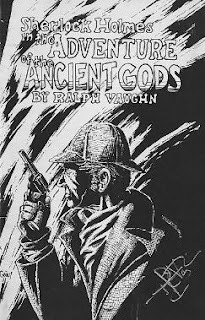 The first book I looked at was Sherlock Holmes in The Adventure of the Ancient Gods. The story was first published in the Trek fanzine "Holmesian Federation." I've already written about the genesis of the story, so won't go into it here, except to say that it does have some significance amongst Holmes/Lovecraft pastiches because it was the very first story to combine the two literary universes, beating the excellent Pulptime by a few years. When Gary Lovisi republished the story as a chapbook, the price was $5. I thought it a little steep at the time, but I knew that specialty publications were often priced in advance of trade-published books. In a recent listing, I found it priced at $45+$4.95 s&h. Of course, I have in the past seen it listed at $60 or so, and, once, for $112 on Amazon by a rare books dealer.
The first book I looked at was Sherlock Holmes in The Adventure of the Ancient Gods. The story was first published in the Trek fanzine "Holmesian Federation." I've already written about the genesis of the story, so won't go into it here, except to say that it does have some significance amongst Holmes/Lovecraft pastiches because it was the very first story to combine the two literary universes, beating the excellent Pulptime by a few years. When Gary Lovisi republished the story as a chapbook, the price was $5. I thought it a little steep at the time, but I knew that specialty publications were often priced in advance of trade-published books. In a recent listing, I found it priced at $45+$4.95 s&h. Of course, I have in the past seen it listed at $60 or so, and, once, for $112 on Amazon by a rare books dealer. The sort-of sequel to the book, Sherlock Holmes in The Dreaming Detective, also published by Gary Lovisi's Gryphon Books was listed recently for $25+$5 s&h. That is more in line with what I would expect for a specialty book now out of print (for the time being), but I have seen other listings in the past asking upwards of $100 for a "Fine to Very Fine" reading copy.
I have to admit that neither listing (Necronomicon Press nor Gryphon Books) really shocked me all that much. After all, the quality was very high, the books were unique and not available elsewhere, and both presses were (and are) highly regarded by scholars, fans and collectors. The shock came when I looked up some of my own Running Dinosaur Press publications.
I have to admit that Running Dinosaur Press was never more than a hobby for me, a creative outlet for myself and others. Despite being a paying market for stories, poems and illustrations, I never made a penny on any booklet. Press runs were meager. When I was invited to sit on a Small Press panel at the 1991 World Fantasy Convention, I represented more the Micro Press than Small Press. And I purposely kept prices at a minimum, just enough to cover production and postage. I truly thought that the chapbooks would never be of interest to anyone but those whose names appeared within.
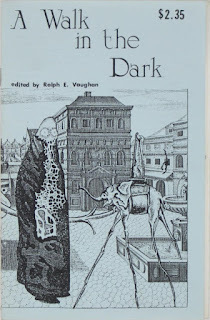
A Walk in the Dark had a horror/dark fantasy theme. I asked for poems about what scared people and received several hundred submissions, out of which I chose 49. It included such notables as Janet Fox, Steve Rasnic Tem, Duane Rimel, t. Winter-Damon, Jessica Amanda Salmonson, Scott Green, and a contribution from Randall Jarrell (posthumously) via his publisher. The cover was light blue, as were all RDP covers, and the price was just $2.35, which included mailing. So I was more than a little surprised when I found a listing offering it for $26.25+$4 s&h.

In Alternate Lives, I gave authors the difficult task of exploring alternate histories, timelines and universes via poems and fiction of 100-200 words. There are a few anthologies that explore the theme, my favorite being Worlds of Maybe , but, let's face it, it's a daunting task to create a new history or timeline, put some characters in it and tell a story in anything shorter than a novel. And, yet, about thirty people accepted the challenge and did a very good job. The price on this booklet was only $1.25 (again, including postage), but I found a listing that offered a copy for $30+$5 s&h.

The last publication I want to look at is HP Lovecraft's Fungi from Yuggoth, his famous sonnet sequence, permission for which I obtained from Arkham House. I wanted to publish this for a hew reasons. I believe there is a story told in the course of the sonnets, and argued that in an issue of Robert Price's Crypt of Cthulhu, and continued that argument in this booklet. Though a few Lovecraftian scholars agree, most do not, so over the years it has become a bit of a tempest in a Lovecraftian teacup. The second reason is that I wanted to illustrate the sonnets, in which I was joined by my good friend Nick Petrosino, who is an accomplished artist and designed much of the armor used in the film Army of Darkness. The third reason...well, what HPL fan does not want to become part of the author's mythos? Anyway, again I charged the minimum I could to cover expenses (yes, Nick was paid, I insisted) and postage, only $2.50. I found several listings in my search, but they were all around $50+s&h. I have to admit this surprised the least, as I know first hand how popular anything connected with HPL is.
So, yes, Belloq was indeed correct. Let enough time pass and almost anything, even me, can become respectable and valued. Who knows? Maybe I will end up in that alien museum after all. As a bonus, let me leave you with one of Nick's illustrations, the one he did for "Antarktos," one of the sonnets.
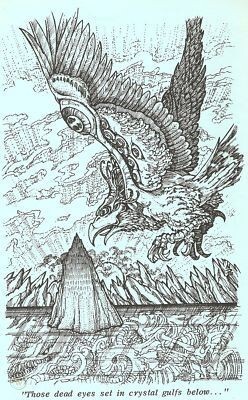
Deep in my dream the great bird whispered queerlyOf the black cone amid the polar waste;Pushing above the ice-sheet lone and drearly,By storm-crazed aeons battered and defaced.Hither no living earth-shapes take their courses,And only pale auroras and faint sunsGlow on that pitted rock, whose primal sourcesAre guessed at dimly by the Elder Ones.
If men should glimpse it, they would merely wonderWhat tricky mound of Natureâs build they spied;But the bird told of vaster parts, that underThe mile-deep ice-shroud crouch and brood and bide.God help the dreamer whose mad visions shewThose dead eyes set in crystal gulfs below!
--H.P. Lovecraft
February 17, 2022
A Dog's Tale
Anyone who has read the books in the Paws & Claws series knows what a soft spot I have for dogs. I have read dozens of books about dogs and books with canine characters in supporting rolls. That includes novels such as White Fang (1906), Greyfriars Bobby (1912) and The Incredible Journey (1961). That also covers quite a few novels that were, to be honest, dogs, and innumerable collections and anthologies with stories that ranged from absolutely the best to you gotta be kidding. This affection even extends to commercials. I sit/stay for the dog-tested/dog-approved commercials from Subaru.
Wildside Press is one of my favorite publishers because of the work they've done to keep in print the work of Golden Age SF & Mystery writers, many of whom have been unfairly forgotten these days. In addition to their "Megapack" collections, they also publish individual shorter works, generally novellas and novelettes, but also some superlative short stories. A case in point is "The Keepers of the House" by Lester del Rey.
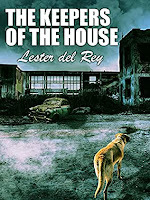 Available where e-books are sold
Available where e-books are soldLester del Rey (1915-1993) is the pseudonym of Leonard Knapp. A major author during the Golden Age of Science Fiction, he is known for such classics as Nerves and Helen O'Loy. He became an influential editor and publisher when he and his wife Judy Lynn del Rey, founded Del Rey Books in 1977, now an imprint of Random House.
In "The Keepers of the House," we meet King, a dog who has been wandering a long time in a world that seems devoid of people. It also seems devoid of land animals since King spends most of his time along rivers catching fish. We begin to understand King is no ordinary dog as he recalls scenes and instances from decades past. If you know dogs at all, you know that one of the cruelest truths of dog ownership is that dogs do not live nearly long enough. The legendary Levi, my pal Skipper and the incomparable Mr Yoda all crossed the Bridge after 19 years, an extraordinary length of time in the canine world, but all too short for me.
In the course of the story, King returns to where it all began for him, the source of his dreams for the past thirty years. It is the campus of a university within a dead and silent city. One of the problems in any apocalyptic science fiction story is relaying information to the reader in a way that is not confusing or boring. That is hard enough when you have an omniscient narrator and/or human characters. The problem here is compounded because, even though there is third-person narration, everything has to be filtered though the limitations and sensibilities of a dog's intellect and experience. However, del Rey does an excellent job, giving us just enough background while never letting us forget that King is just a dog, albeit an extraordinary example of his species.
"The Keepers of the House" was first published in the January 1956 issue of Fantastic Universe Science Fiction magazine. Two years later, it was reprinted in the July 1958 (#73) issue of the British periodical New Worlds Science Fiction. The term "keepers of the house" was probably puzzling to readers at the time, and is apparently just as puzzling to modern readers as well. Few have encountered it except the context of the 1964 novel of the same name by Shirley Ann Grau, a multi-generational saga with themes of racism and hypocrisy in the Deep South. Unfortunately, the true meaning of the phrase is lost in the themes and controversies of the story.
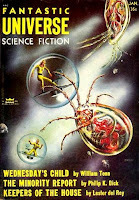
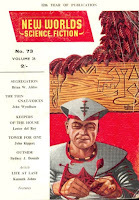
Actually, the term is taken from Ecclesiastes 12:3 in the Bible:
"In the day when the keepers of the house shall tremble, and the strong men shall bow themselves, and the grinders cease because they are few, and those that look out of the windows be darkened..."
Del Rey's interpretation of the verse is more in keeping with its darker original meaning, though, of course, it is filtered through the tropes of science fiction. In the story, the "keepers of the house," essentially the humans who were given stewardship of the world, have failed in their appointed task. They have failed in the eyes of God, failed in their responsibilities to each other and themselves, and have utterly failed King.
I don't know when I last felt so affected by a story. I doubt it would have affected me so deeply had the protagonist been a human. Though humans often portray themselves as victims of others, there is always the underlying truth that we are actually victims of our own choices, right and wrong, and our fates are ultimately in our own clumsy hands. King's fate -- and this is true of all pets -- is in our hands, and in that we failed him, doomed him to wander, just as the government doomed thousands of war dogs abandoned in Vietnam and Afghanistan. Dogs may be Man's best friend, but, more often than not, it is a one-sided loyalty, and we are mostly undeserving of that loyalty. That, perhaps, is the best lesson to take away from "The Keepers of the House."
February 10, 2022
Whatever Happened to Space Cruiser C-57D?

Forbidden Planet (1956) is one of those films that stays with you. It must, because I recall seeing it when it first played at the Bay Theatre in National City. Back in those days, people arrived at the theater whenever they arrived. If they arrived late for the start of a film, they stayed until the film restarted, leaving when they could say, "Ah, this is where I came in." My parents were not great film goers and not at all science fiction fans, so I'm really surprised they went to this film at all. I don't recall the other film, cartoon, newsreel or serial that was also shown that day, but I do recall when they left ("Ah, this is where we came in") because, as I was being carried out (I was much smaller in those days), I saw, over my dad's shoulder, the steps leading to the spaceship bending under the weight of the "monster from the id." I really wanted to stay, but, given that I had already seen the monster, I also really wanted to leave. Looking back, I think I was actually more frightened of the invisible menace, the sight of those metal steps bending when I could see nothing upon them, than I was of the roaring, fiery creature that manifested itself from the savage and primal "id" of Doctor Morbius, augmented by the technomagical devices of the lost Krell Civilization. It is a great film and still holds up now, nearly seventy years later. Unfortunately, MGM chose not to cash in on the success of its surprise hit. So, we have been left to wonder all these years, whatever happened to Space Cruiser C-57D and its intrepid crew after escaping the destruction of Altair IV?
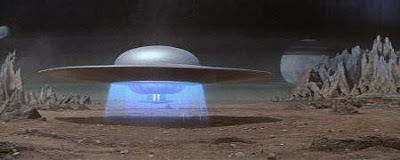
I suppose it was inevitable in this age of fan fiction and instant publication that someone would accept the challenge and give the world the rest of the story. This happened in 2016 when Tony Rubolotta published Forbidden Outpost, a novel "for the fans of Forbidden Planet."
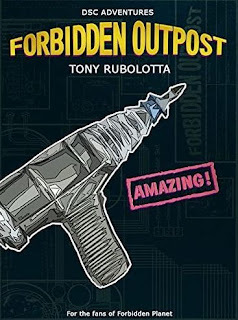 Available from Amazon
Available from AmazonThe rubber-stamped "AMAZING!" on the cover is taken from the promotional poster and lobby card of the film, but it's a fairly apt description of Rubolotta's story. Although there are a few awkward plot elements and an intrusion from a notable frontier stereotype, the author does a very good job of carrying the story forward, expanding upon the characters from the film and fleshing out the world of the United Planets, which was only mentioned in passing in the original film. And, of course, we find out more about the mysterious Krell...a lot more.
I thought one of the most clever aspects of the story was how Rubolotto depicted the human settlement on the planet where a hidden outpost of the Krell survived unsuspected. Instead of reaching into our future, which would have been the book's present, he instead went Retro, drawing upon Mid-Century tropes, types and architecture. Really, it's a great idea. The 1950s is just ancient and alien to the characters in the book as it is to most people now. I don't want to give away anything of the story, but if you like the film, you'll probably like the book.
January 14, 2022
"Holmes, I do not think we are in London anymore."
So, what am I reading at the moment? Well, among many other things a delightful Sherlock Holmes pastiche entitled Sherlock Holmes in Oz by my good friend Gary Lovisi. Yes, as odd as that sounds, Sherlock Holmes, that master of logic and deduction, finds himself in the Wonderful World of Oz, complete with Munchkins, the Yellow Brick Road and, of course, a certain Wicked Witch. A word of warning, however, Gary has based his story on the original 1900 book The Wonderful Wizard of Oz by L. Frank Baum, so don't expect Holmes to break into song with choruses of Munchkins or search for the Ruby Slippers. Those are all products of Hollyweird, not L. Frank Baum's febrile imagination. Adding to the invocation of the original book are the wonderful illustrations by Lucile Cali which are based on the period images by W.W. Denslow.
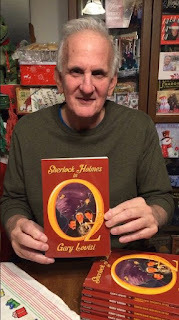
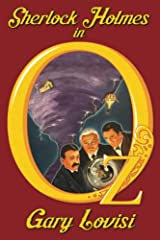 The story begins in London with a new menace taking shape in the East End, an insidious drug involving Red Poppies. Some of the police detectives refer to the addicts as Opium Zombies, resulting in the acronym...well, you get the idea. We also get a flashback to an old case of Holmes', "The Sign of Four," the story in which Dr Watson met of the first of his many wives of indefinite number. Despite this new and pressing case and pressure from Scotland Yard for Holmes' help, the Great Detective decides to help his good friend and biographer Dr John Watson find his great-niece Dorothy, who has gone missing from the plains of Kansas after a great storm.
The story begins in London with a new menace taking shape in the East End, an insidious drug involving Red Poppies. Some of the police detectives refer to the addicts as Opium Zombies, resulting in the acronym...well, you get the idea. We also get a flashback to an old case of Holmes', "The Sign of Four," the story in which Dr Watson met of the first of his many wives of indefinite number. Despite this new and pressing case and pressure from Scotland Yard for Holmes' help, the Great Detective decides to help his good friend and biographer Dr John Watson find his great-niece Dorothy, who has gone missing from the plains of Kansas after a great storm.Gary does a great job of depicting Holmes and Watson, though his vision of Holmes is of a more caring and compassionate man than the one depicted in Watson's jottings. It must be remembered, however, that Watson was writing for a more Penny Dreadful audience, so presenting Holmes as a soulless machine was good for business. It is more likely that Gary's characterization is closer to that of the real Sherlock Holmes. Yet, for all the infusion of humanity, Sherlock Holmes loses nothing of his deductive powers and keen intellect.
While the story contains many fantastical elements (it is Oz after all), I think Gary does very well in maintaining a suspension of belief while adhering to the tenets of the Canon. He does this through spot-on characterization, good plotting, authentic period dialogue, the drawing in of other authorities (such as Professor Challenger), and the ability to present even the most outlandish situations in a calm and logical light. I enjoyed the book very much and recommend it both Sherlock Holmes and Wizard of Oz fans. It is published by Wildside Press and is available there, on Amazon, and other bookselling venues, in both print and digital formats.
I have known Gary Lovisi for a long time. He is a great writer and editor, is the the owner of the legendary Gryphon Books, is an expert on Sherlock Holmes, and frequently contributes to books and magazines about book collecting and pulp fiction, most recently Ed Hulse's The Art of Pulp Fiction.
July 4, 2020
Approaching Dawn
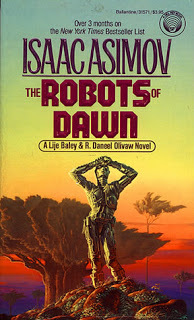 Admittedly, quarantine has not brought any real great changes to my life. I now attend church in my living room Sundays, watching the service streaming over the television on YouTube, and I no longer have to make excuses to keep from going out...having to wear one of those blasted masks is reason enough to stay home. And since we stream instead of using cable or satellite, we miss most of the insipid and virtuous/inspirational commercials. Still, though I can tune out the messages and images (the lonely piano, the solitary car, the idiotic idea that a mask is not a mask), I can't ignore the fact that most of us are on lockdown.
Admittedly, quarantine has not brought any real great changes to my life. I now attend church in my living room Sundays, watching the service streaming over the television on YouTube, and I no longer have to make excuses to keep from going out...having to wear one of those blasted masks is reason enough to stay home. And since we stream instead of using cable or satellite, we miss most of the insipid and virtuous/inspirational commercials. Still, though I can tune out the messages and images (the lonely piano, the solitary car, the idiotic idea that a mask is not a mask), I can't ignore the fact that most of us are on lockdown.I read recently that many people have discovered the joys of not having to rush about madly, the things that can be accomplished by not going out, a clean garage, for example. Employers/employees have found advantages in working from home. Some have even stated that when all this ends (i.e., when politicians have wrung the last bit of power from the crisis) they might be interested in continuing to work from home. Wanting to stay home to work is but a small step from avoiding people as a matter of principal, a mindset I have had for years. Because of my aversion toward socializing, some have termed me "xenophobic,' which is a fear of strangers (a tribal virtue, not a vice), but I think it might be more "anthrophobic," because it's just people in general, a bit stronger than the common social awkwardness most people seem to have to some degree.
I wonder if this enforced isolation might eventually morph into an actual aversion, which brings us to Dawn, a planet in Isaac Asimov's novel The Robots of Dawn, third in his Robot Series, which began with the SF Mystery The Caves of Steel. Again, Earth-based detective Elijah Bailey is called to investigate a crime involving Spacers (those who left Earth centuries before during a period of expansionism), but this time it involves him leaving Earth and its "caves of steel" (vast underground cities) and traveling to Dawn. The problem is that, like all Earthers, Detective Bailey suffers from agoraphobia (a fear of open places), a phobia so strong it nearly cripples him; it stems from the people of Earth spending their entire lives living in the teeming subterranean cities under conditions that others would see as claustrophobic.
The book is wonderfully written and plotted (what novel by Asimov wouldn't be?), though maybe not as well done as the first two books (the aforementioned Caves of Steel and The Naked Sun), but I really don't want to delve into the plot. If you have not read it, I strongly recommend all three.
What made me think of The Robots of Dawn is what Elijah Bailey discovers when he finally reaches Dawn. He has to deal with the wide-open spaces, the spacious houses and the spaces between people, but he discovers the human inhabitants of Dawn have their own bugaboo phobia. Asimov does not call it anthrophobia, but it is. The isolated houses of the Spacer colonists are self-sufficient, they have robots to run their errands and do their bidding, and if they want to visit anyone they can do so by projecting a holographic image. Over time, the inhabitants of Dawn have developed an intense aversion to actual physical presences, a hindrance to the detective's investigation since he is used to living cheek to jowl with his fellow humans and feels restricted in trying to "read" a hologram.
So, are we heading toward being like Dawn's inhabitants? We're getting used to not being around people, and while Zoom is nothing like a hologram, it's a step in that direction. We may not have robots to do our fetching and carrying, but we can get anything we need delivered...yeah, that Prime membership is really paying off. Our houses may not be isolated, but it's easy to shut out the world, even with the front door open.
What would make a conversion from gregariousness to isolationism relatively easy, is that every person really is an island...sorry, John Donne. Despite an incessant bombardment by clueless companies and an increasingly irrelevant government, many people are discoving the truth of the new now: we are all in this...separately, not together. Day by day, we learn we don't need others, we don't need to go out, and if we do need to interact with others, there is Zoom...safe, undemanding, alone and coming with an OFF switch.
March 21, 2020
Writing in the "Age of Plague"
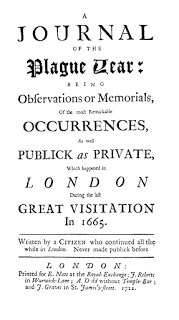 When Daniel Defoe published his novel A Journal of the Plague Year in 1722, people did not think it was a novel at all, but an actual account of events in the year 1665. If anything, they considered Defoe (who would have been five at the time) as the editor, and that his editorial contributions were minimal. The book was even more detailed than the celebrated diaries of Samuel Pepys who actually wrote during the Great Plague (1665-1666). In the work, Defoe mentioned real neighborhoods, real people and even wrote about individual houses.
When Daniel Defoe published his novel A Journal of the Plague Year in 1722, people did not think it was a novel at all, but an actual account of events in the year 1665. If anything, they considered Defoe (who would have been five at the time) as the editor, and that his editorial contributions were minimal. The book was even more detailed than the celebrated diaries of Samuel Pepys who actually wrote during the Great Plague (1665-1666). In the work, Defoe mentioned real neighborhoods, real people and even wrote about individual houses.The book was well received when published and was still well regarded in 1780, but by then it was considered a realistic novel. This is a tribute to Defoe's research skills, for he read hundreds of original documents and interviewed oldsters who had lived through the calamity that struck London, adding to it his own childhood memories. Of course, not every literary scholar and historian considers the case closed on whether or not it's a novel. It lacks the structure of a novel, reads like a memoir and carries a gravitas greater than many historical accounts of the period. The question will probably never be settled.
It's been 298 years since the publishing of the book, 355 years since the setting of the novel, and modern readers probably don't know that Defoe wrote anything other than Robinson Crusoe (another book taken initially as real history), and even fewer remember their history lessons about the Great Plague. Of course, that may change a bit now that we find ourselves beset by the pestilence out of China, which now goes by the name of COVID19 (it's a trendy thing, giving everything an easy-to-recall acronym or portmanteau designation). Being stuck inside for a few weeks, some people might actually pick up that history book they kept from high school, for some reason.
 A few years ago, I had a series of dreams that I converted into plots for novels. Pulling a novel out of a dream is nothing new for me, but this was unusual in that it happened over a two-month period and resulted in about forty different plots. The genres were varied, from science fiction to crime to fantasy to western. When I have more ideas than I can immediately do anything with, I usually jot down the idea, include some mnemonics (to jog my memory later) and sketch a few rough ideas as to characters and setting. This time, however, I gave the stories titles, wrote detailed plots and extensive characterizations, and developed cover ideas using GIMP and Canva. I also typed out the first several pages of the story so I could hit the ground running if/when I came back to it.
A few years ago, I had a series of dreams that I converted into plots for novels. Pulling a novel out of a dream is nothing new for me, but this was unusual in that it happened over a two-month period and resulted in about forty different plots. The genres were varied, from science fiction to crime to fantasy to western. When I have more ideas than I can immediately do anything with, I usually jot down the idea, include some mnemonics (to jog my memory later) and sketch a few rough ideas as to characters and setting. This time, however, I gave the stories titles, wrote detailed plots and extensive characterizations, and developed cover ideas using GIMP and Canva. I also typed out the first several pages of the story so I could hit the ground running if/when I came back to it.After finishing the fifth DCI Ravyn novel, Murder Amongst the Rushes, I thought it was time to take a brief vacation from dark and legend-haunted Hammershire County and pursue a few other projects. I looked in my files and saw that Behind Thick Walls, an amalgamation of the Crime and Post-Apocalyptic genres was the most developed of the stories. It seemed to me that with a working cover, a complete list of characters with full biographies and about a dozen pages of the novel written, it would be a fairly easy matter to dive into the project and get going. And so, in early November 2019, I started work on the novel and wrote in the beginning blurb...
"...but there was nothing natural about the plague that swept the world, seemingly in the twinkling of an eye. Earthâs peoples went to sleep in a time beset by wars and rumors of war, secure in their empires of technology and commerce, and awoke to an Age of Plague."And then, as I worked off and on on it (personal and family situations prevented a concentrated and sustained effort), I found events in the real world warping to mimic the fictional situation. Oh, there were differences, of course. The story is set in Mexico and COVID19 is nowhere near as terrible as the plague in the story, at least not yet. And, while it seems we need only wait out COVID19 (as we did Spanish Flu, Asian Flu and SARS), the plague of the book ("Rot") seems to be the gift that keeps giving.
When I first started, I drew a measure of inspiration from Defoe's book, Pepys' diaries, and the crime novels of Elmore Leonard. As the year turned, and we entered January and February, I discovered my fictional inspiration pushed aside by the news of the day. And now, with California on lock-down for the foreseeable future, I find myself writing about a society beset by plague while living in a society beset by plague. Am I (are we all) trapped in a meta-novel? If so, I hope the cosmic writer is not as cavalier with characters, as I often am.
Hopefully, we won't hear the sound of a Typewriter in the Sky...
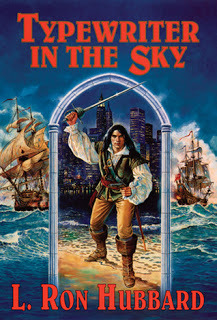
January 29, 2020
More than a Thousand Words
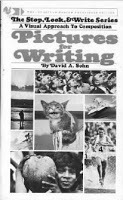 We usually think of the story creating the art, but it can also flow the other way, the art inspiring the words. This is what happened when Edwin Markham saw French artist Jean-François Millet's painting L'homme à la houe and wrote the powerful poem "The Man with the Hoe." When I took a creative writing class at Castle Park High School (it was the first of its kind in the district, strictly experimental) we used a book called Pictures for Writing. This approach was particularly helpful for class members who could write well, but had problems finding inspiration. There were a few other books in the series. The problem that some had with the technique, however, was that they could not get beyond whatever they saw in the picture. Others did quite well transferring the old journalist's mantra of "5W's & an H" (Who, What, Where, When, Why & How) to discover the hidden story. My only problem was that every picture inspired me to write a science fiction or fantasy story; these days, however, it would have been a mystery/suspense story. There were times when I almost felt sorry for Mr Ligon (our teacher) when he read my story, looked at the assigned photo and shook his head in dismay and confusion.
We usually think of the story creating the art, but it can also flow the other way, the art inspiring the words. This is what happened when Edwin Markham saw French artist Jean-François Millet's painting L'homme à la houe and wrote the powerful poem "The Man with the Hoe." When I took a creative writing class at Castle Park High School (it was the first of its kind in the district, strictly experimental) we used a book called Pictures for Writing. This approach was particularly helpful for class members who could write well, but had problems finding inspiration. There were a few other books in the series. The problem that some had with the technique, however, was that they could not get beyond whatever they saw in the picture. Others did quite well transferring the old journalist's mantra of "5W's & an H" (Who, What, Where, When, Why & How) to discover the hidden story. My only problem was that every picture inspired me to write a science fiction or fantasy story; these days, however, it would have been a mystery/suspense story. There were times when I almost felt sorry for Mr Ligon (our teacher) when he read my story, looked at the assigned photo and shook his head in dismay and confusion. Back in the 80's and 90's, I was very active in the small press movement, a kind of counter-traditional publishing that evolved in the later part of the 19th Century. It often took the form of publishing one's own work, but small or "craft" presses also came into being. Until the 60's, when specialized paperbacks took over from the pulps and traditional publishers discovered a new market, science fiction and fantasy novels were published by the likes of Shasta Press and Gnome Books, after first being serialized in genre magazines. Alas, the small press is no more, for which I blame the Internet and Amazon, my usual Black Hats for things that cannot be blamed on the Usual Suspects...fans of The Lone Gunmen will understand. Most of that involvement on my part was as author and publisher, but I also sometimes snuck in as an artist.
However, I never tried to pass myself off as an "artist;" I usually told myself I was just an illustrator, an interpreter of someone else's talent. I read the stories and tried to give the author's words life, choosing just that particular moment that would emphasize the action or distill the essence of the story into vivid graphics. It was just a hobby and I was flattered that people asked me to help them out with their projects. I hope I succeeded more often that I failed. Here are a few of my efforts from published stories:
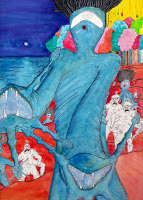 A Plant-man from a re-issue
A Plant-man from a re-issueof one of ERB's Barsoom stories.
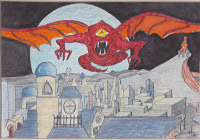 A sorcerer brings doom upon a city
A sorcerer brings doom upon a city
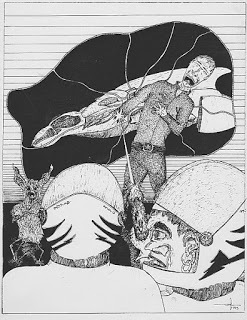 Pirates attack in this space opera.
Pirates attack in this space opera.
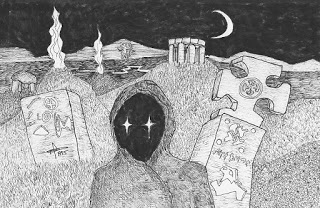 A strange cloaked figure wanders through a Celtic land.
A strange cloaked figure wanders through a Celtic land.Sometimes, I drew illustrations that I would use as a basis for a story, or sometimes I gave them to friends who mined them for stories and poems. However, most of those drawings and paintings I no longer have. This was back in the day before computers and scanners were part of my life. I sent out originals of the works, which were gifts to friends (other small press writers and publishers), whether of not they used them. I do still have a few, though:
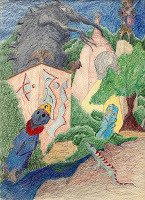
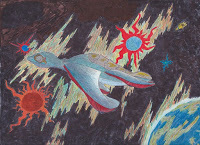

For one reason or another, some of them dealing with trauma, others with the more mundane issues of life and and time and events beyond control (and not a little ennui, admittedly), I put away the pens and pencils and papers for a long time. I suppose if there is one thing that can be said with absolute certainty, it's that nothing remains the same, that everything changes. Everything that goes away comes around again, which is why I try to never throw anything away. So, in 2020, I got the drawing bug again. The difference is that, with the demise of the small press, there went my social life. With just a couple of exceptions, everyone I knew from my small press decades have either moved on to other endeavors or passed away. So, now, if the new drawings are to inspire new stories, it will all be up to me...unless others volunteer.
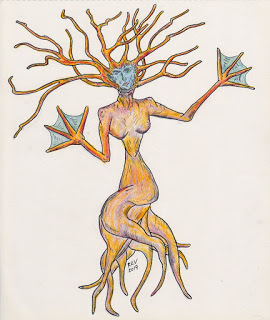 She haunts the bayou, lingering in the moist darkness
She haunts the bayou, lingering in the moist darknessas she watches isolated points of light, the tiny lanterns
of those whose shacks are far from civilization.
And she waits...
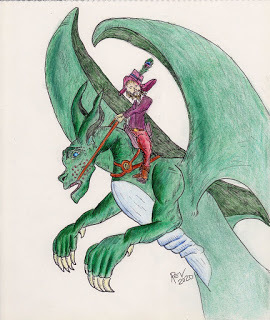 The Canvyrn leads an unhappy life, enslaved and
The Canvyrn leads an unhappy life, enslaved andmistreated by its arrogant and foppish rider;
one day there will surely be a reckoning...
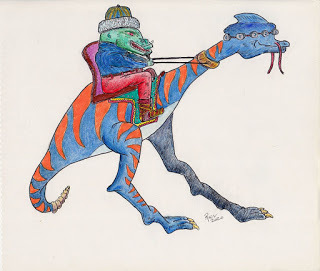 The Davyn and its rider lead caravans across the shifting sands
The Davyn and its rider lead caravans across the shifting sandsof the Great Sand Sea. Though the Davyn has a 360 range of
view and wears goggles to keep his vision clear, the desert is
a dangerous place, full of perils, from savage marauders
to ancient evils...
January 4, 2020
Transformations, Faded Hopes and the Trauma of Change
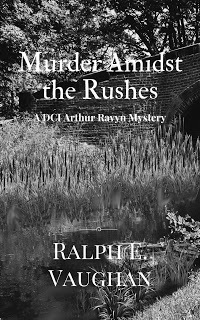 Buy in the US or UKWith Murder Amidst the Rushes, DCI Arthur Ravyn and DS Leo Stark begin their fifth adventure in the legend-haunted English County of Hammershire, and it starts with two men leaving the Mad Badger pub, walking onto the old brick bridge crossing the River Dresal, and only one returning to the pub's car park.
Buy in the US or UKWith Murder Amidst the Rushes, DCI Arthur Ravyn and DS Leo Stark begin their fifth adventure in the legend-haunted English County of Hammershire, and it starts with two men leaving the Mad Badger pub, walking onto the old brick bridge crossing the River Dresal, and only one returning to the pub's car park.Arthur Ravyn has finally recovered from injuries received during the course of events related in Murderer in Shadow. And, finally, Sgt and Mrs Stark have been blessed with their long-anticipated baby, whom they have named Catherine. For once, Ravyn and Stark begin a case without the shadow of Superintendent Heln looming over them; the little fellow has been sent to Paris to attend a crime prevention conference...ah, we can only pity the French.
Each of the previous books in the series had a specific theme, and this book's is Transformations. We all look for ways to change our lives, but change is never as easy as it should be. All too often, any change we might effect has results neither intended nor anticipated. All of us has been so wracked by changes over the years, either through our own efforts or by the actions of others, that it's hard not to hold the belief that, "All change is bad." And it gets worse as we go along. What might have seemed adventurous in our salad years now seems traumatic. I have to admit, however, I am the wrong person to judge the necessity of change...these days, even moving a chair from one side of a room to another is enough to send me into a glassy-eyed stupor. Yeah, change is never good.
But, as the characters in Murder Amidst the Rushes find out, there is no escaping the whims of a cruel and often capricious universe. Some hope for relief from a wretched home life, yet have no idea how to escape. Others try to hold on to what they have, yet events beyond understanding or control take away the dreams and aspirations they had achieved. Then there are those who know what they want, think they know how to achieve those goals, and will not let anything, or anyone, get in their way. When greed and ruthless pursuit become the paramount drivers of a man's life, can murder be far behind? As Stark comes to realize, "Gold makes monsters of all men."
*
*
The book is available in both digital and print editions on Amazon. If you have a Kindle Unlimited subscription ($9.99/month and well worth it, according to the Wife), you can download it to your e-reader and read it at no extra cost...considering you're paying a subscription fee, I don't use the term "free" as others, including Amazon, do. If you have Prime, but not Kindle Unlimited, I think you can still borrow the book as part of the one book a month you're allowed.
Murder Amidst the Rushes has been out for about a month now. The response to it has been very encouraging, and it seems to have sparked renewed interest in the entire Ravyn series by those encountering it for the first time.
For those who have contacted me over the past year with comments and questions, I apologize for the delay in bringing the book into print. It has been a very difficult couple of years, marked by death, illness, surgeries and traumatic events of all sorts. Some I have handled better than others, but each new situation played its part in overcoming my best intentions. Thanks for your patience and encouragement. I truly appreciate your support.
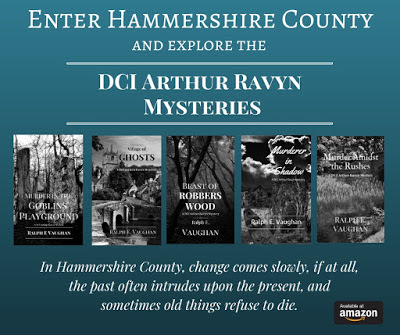 Click HERE to purchase the entire series
Click HERE to purchase the entire seriesNovember 22, 2019
"Since our daughter is no longer with us..."

 The first theater I recall is the Bay Theater in National City. It was built in 1941 and had a distinctive tower with BAY written down it. It was neon-lit and visible from all the roads around. I recall many times seeing that tower from the back seat of my father's or grandfather's car and wishing I were there. It really didn't matter to me what was playing as long as I was there, preferably with a box of popcorn, a cup of soda and a tube of Flicks. We lived in the 1100 block of East 17th Street (unpaved then), a little over a mile from the theater. It was too far away for me to walk alone (so my mother claimed), but I frequently walked down to it with the Eleazar kids from across the street...yes, I know, but it was a different world back then and no one called CPS just because kids were being kids. In addition to the films of the time (e.g., Forbidden Planet and Earth vs The Flying Saucers), I also saw newsreels, cartoons and serials, such as Zombies of the Stratosphere ("Isn't that Leonard Nimoy as the Martian?" asks a dubbed voice in J-Men Forever; "I don't know," replies another dubbed voice, "I can't see his ears."). Then we moved to Chula Vista. The Bay Theater later came to an ignominious end -- first it became a Spanish church, then high winds blew the tower down. I don't know if one had anything to do with the other, but at least it was something that wasn't my fault...for once.
The first theater I recall is the Bay Theater in National City. It was built in 1941 and had a distinctive tower with BAY written down it. It was neon-lit and visible from all the roads around. I recall many times seeing that tower from the back seat of my father's or grandfather's car and wishing I were there. It really didn't matter to me what was playing as long as I was there, preferably with a box of popcorn, a cup of soda and a tube of Flicks. We lived in the 1100 block of East 17th Street (unpaved then), a little over a mile from the theater. It was too far away for me to walk alone (so my mother claimed), but I frequently walked down to it with the Eleazar kids from across the street...yes, I know, but it was a different world back then and no one called CPS just because kids were being kids. In addition to the films of the time (e.g., Forbidden Planet and Earth vs The Flying Saucers), I also saw newsreels, cartoons and serials, such as Zombies of the Stratosphere ("Isn't that Leonard Nimoy as the Martian?" asks a dubbed voice in J-Men Forever; "I don't know," replies another dubbed voice, "I can't see his ears."). Then we moved to Chula Vista. The Bay Theater later came to an ignominious end -- first it became a Spanish church, then high winds blew the tower down. I don't know if one had anything to do with the other, but at least it was something that wasn't my fault...for once.When we moved to Chula Vista, I discovered the local theater, the Vogue, was even father away than the Bay. But, it was still a different world, so off I went. I didn't have older kids to walk with me anymore, but I figured what my mother didn't know couldn't hurt me. Besides, I was nine by then, almost an adult. Yes, I lived dangerously...I even drank water straight out of the hose. You might say I grew up in Chula Vista, but I also grew up in the Vogue Theatre (note the classy English spelling) watching every film my parents wouldn't take me to see...they were never big movie goers, but I never held that against them, much.
 The Vogue in better daysWhen the Wife and I had kids, I looked forward to not going to the cinema alone...the Wife would go from time to time, but she did not revel in the experience as I did. Too many people, she claimed. Especially too many unruly kids. I have to admit, she had a point there. When I went to the movies as a kid, I was never unruly. No, really! It would have been a shock to both my mother and my teachers had they seen how well behaved I was when the lights went down, the curtains parted and the film began. But I was there for the film, and once the film started, I was a part of it, totally absorbed.
The Vogue in better daysWhen the Wife and I had kids, I looked forward to not going to the cinema alone...the Wife would go from time to time, but she did not revel in the experience as I did. Too many people, she claimed. Especially too many unruly kids. I have to admit, she had a point there. When I went to the movies as a kid, I was never unruly. No, really! It would have been a shock to both my mother and my teachers had they seen how well behaved I was when the lights went down, the curtains parted and the film began. But I was there for the film, and once the film started, I was a part of it, totally absorbed.Unfortunately, our son was never really a devoted film goer. Oh, he like going to the movies, all right, but it had to be a film he was interested in, such as Star Wars. Our daughter (the Kidette), however, had tastes that were as catholic as mine. Well, let's just say she didn't complain no matter what film I dragged her to. Likewise, I can't count the number of chick-flicks and teen-angst movies she took me to. And, please, don't ask me how many times I saw Center Stage. But it was all enjoyable, every single film. Mostly, though, because the Kidette was with me.
One of our traditions was to get a tub of popcorn and a large soda. The Vogue had a policy that if you brought back the receipt you got a free refill. Great. Whether it was a double feature or a triple, we had more than enough to last us to the final end credits of the final movie, and we always stayed for the last credit. Unfortunately, time passed and our daughter moved. I was back to solitary viewings.
It should have occurred to me that I could not possibly eat two full tubs of buttered popcorn, but it didn't. The first time I went without the Kidette, I bought a tub and was more than stuffed by the time I got to the end of it. What to do? My Protestant ethic screamed at the prospect of that free refill going to waste. I then noticed a mom and her kids sitting in front of me. They had no popcorn.
Me: Pardon me ma'am, but would you and your kids like a free popcorn?
Her: Uh...
Me: I have a receipt for a tub of popcorn, and the theater gives free refills.
Her: Uh...well...
Me: My daughter and I used to share a tub at the movies, but she's no longer with us, and I can't eat the whole thing myself.
Her: Oh, you poor man. I am so sorry. Thank you very much.
After she took the receipt and scurried off to get the free popcorn, I realized how she must have interpreted what I said. I changed seats. "Dad!" my daughter scolded. "You made her think I was dead. I only moved out. I didn't die!" Well, really, is my fault she took it that way? I didn't say anything that wasn't true...that's my story and I'm sticking to it.
 The Vogue in badder daysUnfortunately, nothing lasts forever, and just as that applies to little boys and dragons, so it also applies to movie theaters. The Vogue opened in the winter of 1945 and closed its doors in the summer of 2006, after showing a triple-feature of Fast & Furious: Tokyo Drift, Over the Hedge and Poseidon. I really didn't want to tell the Kidette about the fate of our beloved theater. So when she came down for a visit I put her in the car and drove down Third Avenue. She didn't cry...well, not much.
The Vogue in badder daysUnfortunately, nothing lasts forever, and just as that applies to little boys and dragons, so it also applies to movie theaters. The Vogue opened in the winter of 1945 and closed its doors in the summer of 2006, after showing a triple-feature of Fast & Furious: Tokyo Drift, Over the Hedge and Poseidon. I really didn't want to tell the Kidette about the fate of our beloved theater. So when she came down for a visit I put her in the car and drove down Third Avenue. She didn't cry...well, not much. The Vogue's Facebook page - link below
The Vogue's Facebook page - link belowSometimes the dead return, or so Stephen King and HP Lovecraft tell us, and that may be the fate of the Vogue. According to its Facebook page, the Vogue is being renovated as an entertainment, event and dining/drinking experience. They also claim they are going to maintain the historic exterior. I hope that's true, but, of course, it will never be the same. Still, if I look at the facade and see it restored to its former glory, I will fondly relive better days. If all that comes to pass, I will probably go to the proposed outdoor dining area, have a beer and raise a glass to toast my my movie memories.



